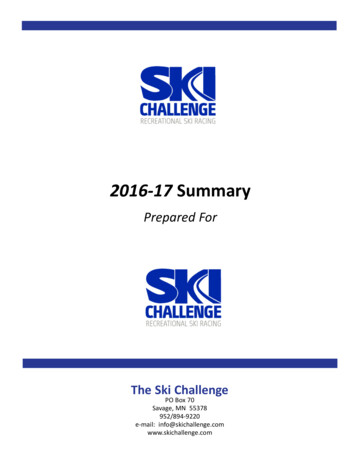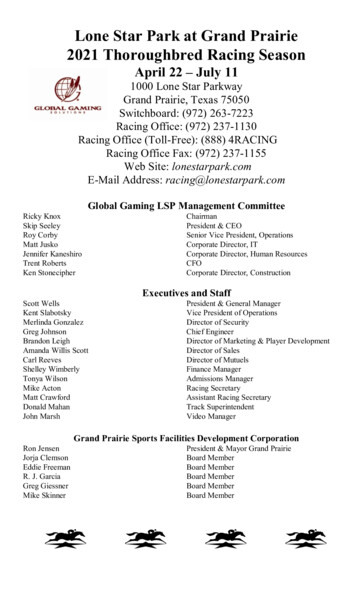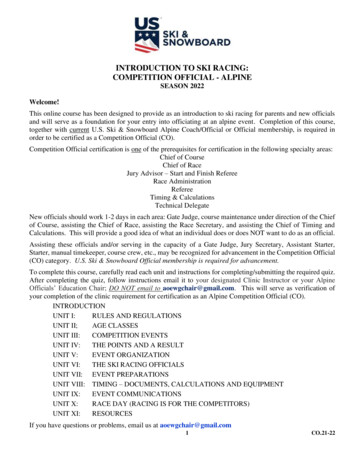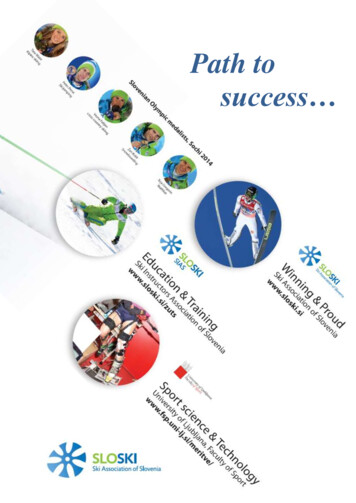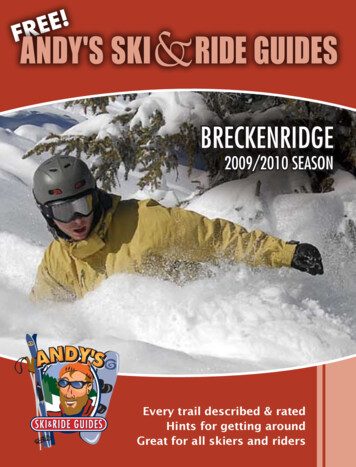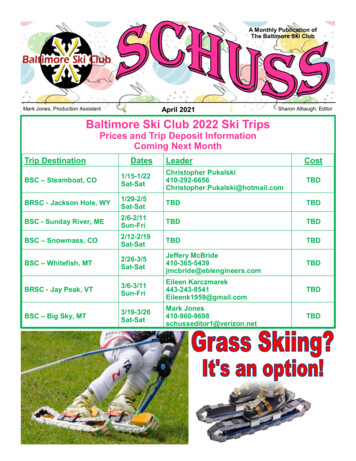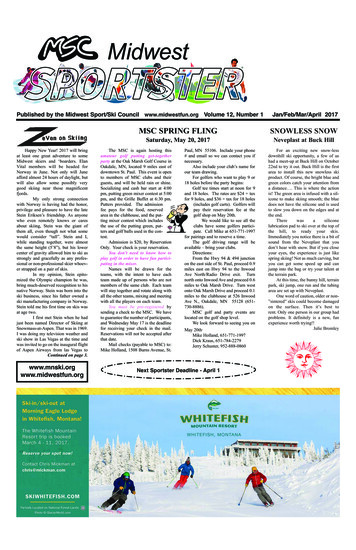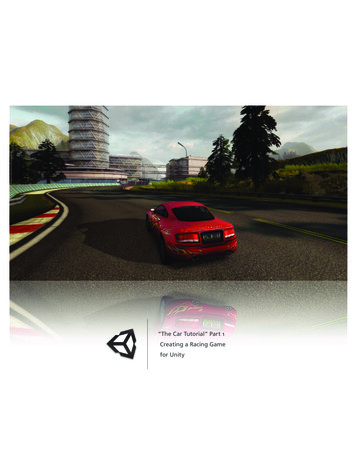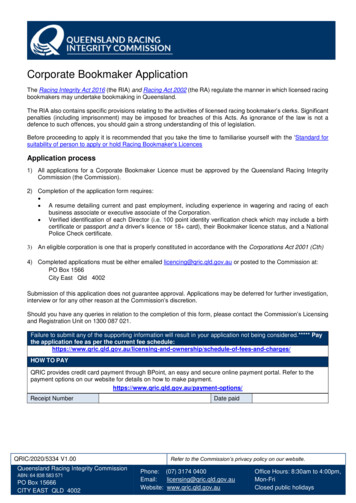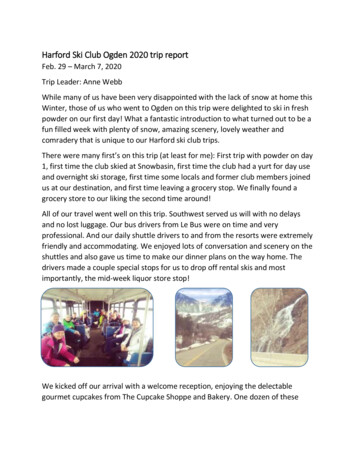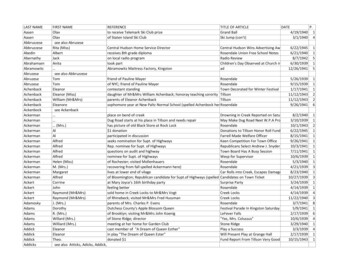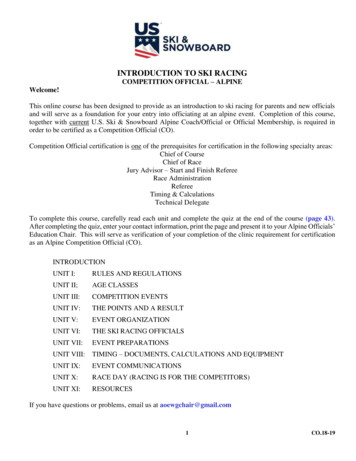
Transcription
INTRODUCTION TO SKI RACINGCOMPETITION OFFICIAL – ALPINEWelcome!This online course has been designed to provide as an introduction to ski racing for parents and new officialsand will serve as a foundation for your entry into officiating at an alpine event. Completion of this course,together with current U.S. Ski & Snowboard Alpine Coach/Official or Official Membership, is required inorder to be certified as a Competition Official (CO).Competition Official certification is one of the prerequisites for certification in the following specialty areas:Chief of CourseChief of RaceJury Advisor – Start and Finish RefereeRace AdministrationRefereeTiming & CalculationsTechnical DelegateTo complete this course, carefully read each unit and complete the quiz at the end of the course (page 43).After completing the quiz, enter your contact information, print the page and present it to your Alpine Officials’Education Chair. This will serve as verification of your completion of the clinic requirement for certificationas an Alpine Competition Official (CO).INTRODUCTIONUNIT I:RULES AND REGULATIONSUNIT II;AGE CLASSESUNIT III:COMPETITION EVENTSUNIT IV:THE POINTS AND A RESULTUNIT V:EVENT ORGANIZATIONUNIT VI:THE SKI RACING OFFICIALSUNIT VII:EVENT PREPARATIONSUNIT VIII:TIMING – DOCUMENTS, CALCULATIONS AND EQUIPMENTUNIT IX:EVENT COMMUNICATIONSUNIT X:RACE DAY (RACING IS FOR THE COMPETITORS)UNIT XI:RESOURCESIf you have questions or problems, email us at aoewgchair@gmail.com1CO.18-19
U.S. SKI & SNOWBOARDINTRODUCTION TO SKI RACING:COMPETITION OFFICIAL - ALPINE2018-2019INTRODUCTIONThere are numerous jobs available for parents and volunteers. Some require better skiing skills, but many canbe performed by anyone regardless of their level of skiing ability – even non-skiers may apply!This course will contain many references to specific documents/forms which are part of the “Master Packet ofForms” (MPF) which is located on the U.S. Ski & Snowboard website. The following documents providereferences to terminology used throughout this course and can be found at the end of this presentation (pages30-43). Print and keep them handy for reference as you proceed.Document numbering is not sequential because it agrees with document numbering in the updated “MasterPacket of Forms” (MPF) which can be found on the U.S. Ski & Snowboard websiteAbbreviations and TerminologyPersonnel at the Race34. Report by the Referee29. Start/Finish Timekeeper Recording Form61. & 62. “Fault Only” Gate Judge Card (Gate Keeper) and Instructions*63. & 64. “Fault/No Fault” Gate Judge Card (Gate Keeper) and Instructions*70. Alpine Official’s Personal Activity Record71. Alpine Official’s Recommendation Form20. Volunteer Competition Worker Registration Form*Includes instructions for hiking for single-pole SlalomI.RULES AND REGULATIONSIt is the responsibility of every official and competitor to know, understand and abide by the rules forthe sport. One of the questions most often asked by people new to the world of ski racing is: “Wheredo all these rules come from?” In overview form, this is an outline of the various sources of rules andguidelines.International Rules - FIS International Rules of Competition (ICR):The Federation Internationale de Ski, known as FIS (pronounced “fiss”), is the world governing bodyof ski racing. It establishes the standards to which all national governing bodies must conform.The International Ski Competition Rules, also known as the ICR, is published by the FIS Office;“Precisions”, if required, are published prior to the start of the competition season. Updatedpublications are posted on the FIS website at fis-ski.com and are also available through a link on theU.S. Ski & Snowboard website. The FIS Office is the only valid source for official rules governing aFIS event.The ICR forms the basis for all alpine ski competitions sanctioned by a national governing body.“Precisions” (updates) are published biannually, once in early summer for the Southern Hemisphereand again in November for the Northern Hemisphere.2CO.18-19
The FIS Office publishes additional rule books which address particular requirements for specific topicand different levels of competition. These include, but are not limited to, Rules of the FIS Points, Rulesfor the Alpine FIS Continental Cups, Rules for the Alpine FIS Ski World Cup, and Specifications forCompetition Equipment. These rule books are updated every season; if additional updates are required,they are published in the “Precisions”.U.S. Ski & Snowboard Rules:U.S. Ski & Snowboard is the national governing body (NGB) for the sport of skiing and snowboardingin the United States. It establishes the standards to which all Regions/Divisions must conform.U.S. Ski & Snowboard, in conjunction with the United States Olympic Committee (USOC) and theInternational Olympic Committee (IOC), sponsors the U.S. Ski Team, and any World Cup, WorldChampionship and Olympic competitions held in this country.U.S. Ski & Snowboard publishes its alpine rules and regulations as the U.S. Ski & Snowboard AlpineCompetition Regulations or ACR. * [These rules and regulations are not applicable at FIS events.] Thenumbering of the ACR mirrors, when possible, ICR rule numbering, and U.S. Ski & Snowboardexceptions to these rules are identified with a “U” preceding the rule number; the “U” is a part of theU.S. Ski & Snowboard rule number. *The FIS International Competition Regulations (ICR) andadjuncts shall govern any and all issues not addressed therein.Regional/Divisional Rules:Each Region/Division may also publish rules for competitions held in their respective areas. Theserules are limited in scope, govern eligibility requirements and may also amend certain restrictionswithin age classes. Regional/Divisional rules are usually published annually in a handbook and mayalso be found on U.S. Ski & Snowboard Region/Division websites.Local Rules:Local rules are published in the material distributed for individual events; this material is often referredto as the event “Race Announcement” or “Fact Sheet” or daily “Program”. These rules govern suchmatters as the local ski area rules and regulations, restrictions for lift access, deposits required for racingbibs and other issues related to a specific event.II.THE AGE CLASSESSki racing is structured to provide a progression of basic skills and racing ability through the course ofa competitor’s career. Competition is a necessary element of all ski racing; however, results are notemphasized at the younger age levels. The youngest athletes are nurtured and reaffirmed; fun andpersonal improvement are emphasized over results.Athletes are taught the fundamentals and basic skill required for ski racing. As they mature, advancedskills are introduced as is developmentally appropriate, and they are exposed to more intense levels ofcompetition where their skills are challenged to greater degrees.A competitor’s age class is determined by their age on December 31 of the current competition year.The current competition year is 2018-2019, so a competitor’s age class is determined by their actualage on December 31, 2018.Instructional Levels – U8, U10, and U12:U8 (under 8), athletes are 7 and younger; U10 (under 10), athletes are 8 and 9 years of age; and U12(under 12), athletes are 10 and 11 years of age. U8 category, although recognized by U.S. Ski &3CO.18-19
Snowboard, is basically established for the purpose of awards; U8 course setting is governed by U10course setting specifications.These first three levels, or age classes, are those that establish a forum for teaching fundamentals andbasic racing skills and for having fun.These younger athletes race at an instructional level. Racecourses are basic and are set to test a rangeof fundamental skills with an emphasis on fun and improvement of fundamental skiing and racingskills.Some Regions/Divisions do not allow competitors at these levels to employ specialized equipment.For example, only one pair of skis may be allowed for the different types of events.U14 Competitive Level:U14 (under 14), athletes are 12 and 13 years of age.This is the first competitive level in which all event types are explored. Racecourses follow the U.S.Ski & Snowboard guidelines. Timing is used for events at this level, and some Regions/Divisionsallow these events to be scored to the National Points System.Results are recognized with trophies and/or medals in the same manner as in upper level races. Theemphasis is on fun and improvement through the use of advanced skills.U16, U19, U21, & Senior Competitive Level:U16 (under 16), athletes are 14 and 15 years of age; U 19 (under 19), athletes are 16, 17 and 18 yearsof age; U21 (under 21), athletes are 19 and 20 years of age; and Senior athletes are 21 years of age andolder.U16 is the first competitive level where races are scored and competitors can earn points by which theyare ranked at the national (U.S. Ski & Snowboard) level. Athletes U19 and older can earn such seedingpoints at both the national (U.S. Ski & Snowboard) and international (FIS) levels. At this level, seedpoints are used to rank competitors for first-run start orders. Racecourses follow the U.S. Ski &Snowboard and, when applicable, the FIS guidelines and are set according to the level of competitionas well as the ability of the field.The emphasis is on advancing multi-event racing skills and preparing athletes for competing in upperlevel events.Other U.S. Ski & Snowboard Racing Opportunities:Collegiate Ski Competition:Collegiate ski competition is an important part of the sport in the United States as it provides postsecondary school age competitors the opportunity to continue their ambitions in ski racing whilepursuing goals in education. College athletes who are U.S. Ski & Snowboard competitor members haveaccess to the U.S. Ski & Snowboard National Points List. Many college meets are scored for U.S. Ski& Snowboard points while some meets are organized as FIS-University events where FIS points andinternational rankings may be achieved.There are two national collegiate programs: The National Collegiate Athletic Association (NCAA),and the U.S. Collegiate Ski and Snowboard Association (USCSA); both programs are actively involved4CO.18-19
with the policy-making process of U.S. Ski & Snowboard through the U.S. Ski & Snowboard AlpineCollegiate Working Group.The NCAA varsity team regional college circuits in the East (EISA-Eastern Intercollegiate SkiAssociation) and in the Rockies (RMISA-Rocky Mountain Intercollegiate Ski Association) offer accessto the NCAA Skiing Championships. The USCSA offers programs from full varsity teams to clubsport teams. Organized into 11 conferences, the USCSA provides opportunities for athletes to qualifyto one of the six regional championships leading to the USCSA Championships. Both championshipseries boast elite levels of competition and awards national recognition for their respective programs.In addition to collegiate leagues, many high school athletic associations have successful high schoolleagues that promote snow sport.Effective season 2019, U.S. Ski & Snowboard has reintroduced a “non-scored Student membership”.The membership is designed for students 14-24 years of age prior to December 31 of a competitionyear. (A competition year is July 1 to June 30.) This membership is primarily intended forinterscholastic and intercollegiate racing. This membership provides access to all levels of U.S. Ski &Snowboard scored and non-scored competitions at the local, divisional, regional and national level.However, as the name implies it does not include access to the U.S. Ski & Snowboard National PointsList.In an attempt to introduce U.S. Ski & Snowboard competition to a broader base of the skiingpopulation, U.S. Ski & Snowboard has formed a working relationship with NASTAR.Adaptive Ski Racing – Adaptive Competition:Adaptive skiing started in pre-World War II Europe and involves individual with mobility impairments– amputees and paraplegics, as well as those with visual impairments.Adaptive skiing began as a rehabilitation/recreation program that evolved into well-organized nationaland international competitions. Elite-level competitions exist both nationally and internationally up tothe Paralympic and IPC World Cup levels.Adaptive skiing has a three division, multi-class system for determining medals/awards, based onfactored time on course. Classifications are based on physical impairment and type of equipmentrequired by the impairment. Competitors are seeded according to classification and earned seed points.In order to encourage adaptive athlete participation in able-bodied U.S. Ski & Snowboard-sanctionedcompetition, U.S. Ski & Snowboard has adopted a special seeding rule for adaptive competitors. The“Golden Rule” was proposed by Adaptive World Champion, the late Diana Golden, and authorizesspecial start order(s) as outlined in the current Alpine Competition Guide for adaptive athletescompeting in U.S. Ski & Snowboard-sanctioned able-bodied competitions. Except for the specificapplication of the “Golden Rule”, adaptive competitors participating in able-bodied races do soaccording to the rules, procedures and scoring of those events. (“Golden Rule” seeding may not beused at FIS events.)Recreational Adult Racing – Masters:Masters level racing is recreational racing for adults, 18 and older. The events are organized and scoredaccording to prescribed rules.5CO.18-19
Racecourses follow the U.S. Ski & Snowboard and FIS guidelines, as modified by the Masters Groupand are set competitively. Races are timed and scored according to divisional rules, and results arerecognized. The Masters events emphasize social camaraderie, improvement of skiing and racingskills, and the challenge of competition.III.THE EVENTS – Slalom, Giant Slalom, Downhill, Super G, Alpine Combined, Kombi, andParallel:(Disciplines are branches of a sport and may comprise one or several events. For example, CrossCountry, Nordic, Freestyle and Snowboard are disciplines of snow sport and the following are eventsin the Alpine Skiing discipline.)Slalom (SL) is a technical event that requires the execution of many short, quick turns. The course ismade up of various gate combinations designed to test a competitor’s skill and strategy. SL is stagedin two runs that must be held on the same day with times added together to determine final finish order.SL for youth may be conducted in either one or two runs.Giant Slalom (GS), also a technical event, is often characterized as the event that requires the mosttechnical skill since competitors have to race down the mountain through a faster and more open coursethan slalom. GS is staged in two runs that, whenever possible, should be held on the same day withtimes added together to determine final finish order. GS for youth may be conducted in either one ortwo runs. Depending on the terrain and the course set, the Jury may designate “yellow flag zones” inorder to stop on-course competitors who are approaching a “start stop” situation.Downhill (DH) is a speed event characterized by a course that tends to follow the contours of the hillor trail and thus allows the competitors some freedom to find the fastest “line”. Downhill is generallya one-run event; however, in cases where required vertical drop is not possible or the winner’s time isnot equal to a minimum winning time prescribed in the U.S. Ski & Snowboard Alpine CompetitionRegulations (ACR), a downhill in two runs (Sprint Downhill), may be staged. Downhill is restrictedto Senior, U21, U19, U16 and U14 competitors; however, U14 competitors may compete only in thoseDownhill events that adhere to special rules. All Downhill courses have “yellow flag zones”. Theseare areas designated by the Jury for stopping on-course competitors who are approaching a “start stop”situation. All events require that movement on course be limited. Downhill requires that, with theexception of the racer on course, there be NO movement. This is commonly called a “course freeze”;the course freeze time is noted on the daily Program by indicating when coaches must be in place.Super Giant Slalom (SG), a speed event, is a hybrid of downhill and giant slalom. Super G is alwaysa one-run event and is restricted to Senior, U21, U19, U16, U14 and U12 competitors. U14 and U12competitors may only compete in Super G events that adhere to special rules and the U.S. Ski &Snowboard rules do not allow Super G for younger age groups. Super G courses also have “yellowflag zones”; areas designated by the Jury for stopping on-course competitors who are approaching a“start stop” situation. All events require that movement on course be limited. Super G requires that,with the exception of the racer on course, there be NO movement. This is commonly called a “coursefreeze”; the course freeze time is noted on the daily Program by indicating when coaches must be inplace.Alpine Combined (AC) is a two-run event composed of a speed event – either one run of Downhill orSuper G and a technical event – one run of Slalom. The speed portion is usually staged first, but rulesare in place which allow for staging the Slalom first. Rules for the individual events, combined withrules for two-run races, are in effect. Alpine Combined events are currently not being staged for youth.Please refer to current rule books for complete information.6CO.18-19
Kombi (K) is an internationally recognized event for youth racing that consists of a mixture of standardturns and gates. The event meets development needs for these younger age groups, creating tacticalawareness by blending sections of different gates in a flowing, rhythmical, constantly changing pattern.The SL/GS Kombi format is a technical orientation based on SL and GS; the GS/SG Kombi format isa speed orientation based on GS and SG.Parallel (P) events are competitions where two competitors race simultaneously side by side down oneof two separate but identical courses. Results are based on either a one-run format or a two-runcombined-time format. If the two-run combined time format is used, the racers then switch courses fortheir second run. Overall winner is decided either by fastest time on course (1- run format) or fastestcombined time (2-run format).These results may then be used to establish “bracket seeding”. If brackets are being utilized, thewinners of each round advance through remaining “brackets” (elimination-type rounds) to “small” (3rdand 4th place) and “big” finals (1st and 2nd place).Helmet:U.S. Ski & Snowboard and FIS rules require that competitors and forerunners wear appropriate helmetsfor all ski racing events. U14 and older participants must wear helmets that conform to FISSpecifications or they will not be allowed start; this requirement is applicable for both non-FIS and FISevents. Helmet specifications are more fully described in applicable rule books.Yellow Flag Zones;Speed events – Downhill and Super G – all have designated “yellow flag zones”. These are areasdesignated to stop on-course competitors who are approaching a “start stop” situation. Depending onthe terrain and the course set, the Jury may designate yellow flag zones for Giant Slalom.IV.THE POINTS and a RESULT“Points” and “Results” will be referred to many times in this and other specialty-area Study Guides. Abrief description of these items as they apply to alpine skiing are:Seed Points are a numerical indicator based on a competitor’s best two results in an event and are usedfor seeding at scored events. These points indicate an individual’s standing among other competitorsin an event; 0.00 is the best and 999.99 is assigned to competitors new to the U.S. Ski & Snowboardpoints system. FIS points are calculated from 0.00 to 999.00.- U.S. Ski & Snowboard National Points for nationally-scored events- FIS Points for internationally-scored eventsU.S. Ski & Snowboard National Points are tracked and published by U.S. Ski & Snowboard; FIS Pointsare tracked and published by the FIS Office. When an error occurs, the points can only be correctedby the organization responsible for their tracking/publication.Race Points are a calculated number that compares an individual’s time to the winner's time in aparticular race. The winner’s Race Points are always 0.00. All other competitors have positive racepoints as a component of their race result.Penalty Points are a numerical indicator that allows an event at one site to be equalized to the sametype of event held at another site and have been proven to be remarkably accurate across all race penaltylevels.7CO.18-19
Race Result is a racer’s score for a given event. It is the sum of the racer’s earned Race Points addedto the calculated Penalty Points for the event. When a Race Result is equal to a racer’s current SeedPoints, they are said to be “skiing to their Seed Points.” When a Race Result is lower than a racer’scurrent Seed Points, and if averaged with a second similar result, a lower seed point value will beidentified in the publication of the next U.S. Ski & Snowboard or FIS Points List. (FIS results for U.S.Ski & Snowboard member athletes are included in calculation of updated U.S. Ski & SnowboardNational Points.)Formulas for calculating Race Points and Penalty Points may be found in the U.S. Ski & SnowboardAlpine Competition Guide and/or the current FIS Rules for the FIS Points, as well as in Timing &Calculations Alpine Officials’ Clinic materials.V.EVENT ORGANIZATION: (Refer to Abbreviations and Terminology; Personnel at the Race)Organizing Committee (OC):With the exception of higher-level events, the sponsoring U.S. Ski & Snowboard-member club orassociation serves as the Organizing Committee. The Organizing Committee consists of thosemembers (physical or legal) who are delegated by the organizer and U.S. Ski & Snowboard and carriesthe rights, duties and obligations of the organizer.At upper-level races, the sponsoring club or association may appoint an Organizing Committee toaddress the many issues associated with the event, e.g. marketing, media liaison, housing,transportation, etc. This type or organization is generally only in place for National Championships,Continental Cup events or World Cup events.The Chief of Race is Chair of the Organizing Committee. Upon appointment, the Technical Delegate,Referee and Assistant Referee (for speed events), and the Forerunners also become members of theOrganizing Committee.Organizing Committee Members:Chief of Race (is the Chair)Secretary (not always the Race Administrator/Race Secretary)Technical DelegateReferee (upon appointment)Assistant Referee (upon appointment for speed events only)Forerunners (upon appointment)Additional members for upper-level events may include:Chair of FinanceChair of TransportationChair of LodgingChief of Medical and Rescue ServicesChief of CourseChair of Media Relations/Chief of PressChief Gate JudgeChair of AwardsChief of Course Equipment8CO.18-19
Competition Jury:Technical Delegate: Chairperson of the Jury and has the deciding vote in case of tiesReferee (has vote)Chief of Race (has vote)Assistant Referee (speed events only, has vote)Jury Advisors:The following are considered Jury Advisor position. They have a voice in Jury meetings but do nothave a vote *:Start RefereeFinish Referee* (At higher level events – FIS World Championships and Olympic Winter Games, the Start and FinishReferees are appointed by FIS, are members of the Jury and do have a vote.)The Jury’s tenure begins with the first Team Captains’ Meeting prior to the start of training and endswith the expiration of the protest period or settlement of all protests and the approval of the OfficialResults.The Jury carries out all duties for which it is responsible according to the ACR for U.S. Ski &Snowboard events and the ICR for FIS events. It also makes decisions on all questions not clarified bythe rules. The Jury considers all the facts regarding infringements against rules and decides whetheror not sanction is required.Membership Requirements:For all U.S. Ski & Snowboard-sanctioned, non-FIS events, Jury members, Jury Advisors (Start andFinish Referee), Chief of Course, Course Setters, Chief of Timing & Calculations and RaceAdministrator must be current members of U.S. Ski & Snowboard as a Coach or an Official (“Official”membership is included in “Coach” membership). They must also be appropriately certified for theirposition and have attended a biennial Alpine Officials’ Review & Update. Officials who do not meetmembership, certification and/or update requirements may not be appointed to serve in the abovepositions.Coaches representing USA competitors must have a current U.S. Ski & Snowboard Coach membershipin order to participate in any capacity at any U.S. Ski & Snowboard event, e.g. on-hill coaching.Competitors are required to have current, appropriate U.S. Ski & Snowboard competition membership:Competitor, Master, non-scored Student or Short Term Athlete. Qualified members of foreignfederations recognized by FIS must also be current U.S. Ski & Snowboard members in order to takepart in any official capacity, including forerunning, at a U.S. Ski & Snowboard-sanctioned non-FISevent.Available Memberships:CategoryAge Parameters*Competitor U109 & underCompetitor U1210 & 11Competitor U1412 & 13Competitor U16 14 & overNotesRequired for FIS registration (U19 – Senior), includespoints/rankings9CO.18-19
Non-Scored Student 14-24General MemberAll agesMastersCoach18 & over18 & overOfficial18 & overClub Volunteer18 & overParticipation in all levels of U.S. Ski & Snowboardcompetition, including Masters; does not includepoints/rankings.USCSA/High School/Club Participant. Not eligible forU.S. Ski & Snowboard competition; eligible forforerunningPeriodic background screening & SafeSport trainingrequiredPeriodic background screening & SafeSport trainingrequiredPeriodic background screening & SafeSport trainingrequired; not eligible to serve as a forerunner or as anofficial, e.g. Jury, Course Setter, Jury Advisor, Chief ofCourse, etc.A Short Term (per-day) membership category is available that allows members to try differentevents/disciplines without having to obtain full Competitor membership. Short Term memberships arelimited to two (2) per person per season and are not available for participation as a Coach, Official orClub Volunteer.Short Term memberships are available for:Short Term Youth U1211 & underShort Term Athlete U14 12 & overShort Term Masters18 & over*Age is determined by actual age on December 31 of the actual competition season.U.S. Ski & Snowboard Online Membership:1. Apply for or renew your U.S. Ski & Snowboard Coach or Official membership online atussskiandsnowboard.org. Create (new members) or access your “User Account” and select allrequested memberships, e.g. Coach/Official, Competitor – Alpine, U.S. Ski & Snowboard ClubVolunteer, U.S. Ski & Snowboard Club Participant, Snowboard, Freestyle, Masters, etc.2. Enter or affirm previously supplied primary medical/accident insurance information3. Coaches who are non-certified member coaches must review and complete the “Fast Start CoachingCourse”4. All members must review and accept “Assumption of Risk and Release of Liability”. (Readcarefully before accepting.)5. All members must review and accept “U.S. Ski & Snowboard’s Concussion Policy”6. All members must review and accept “U.S. Ski & Snowboard’s Child Protection Policy Safe SportGuidelines”7. Upon receipt and processing of your application, if either SafeSport training, background screeningand/or Fast Start Coaching Course are required, U.S. Ski & Snowboard will either direct you to alink that will initiate the required process or you will be contacted via email with instructions onhow to proceed. Failure to complete requirements will result in membership being inactivated.8. Site will provide membership fee total.9. Credit card holder must provide current credit card information.10CO.18-19
10. If either background screening, SafeSport training and/or Fast Start Coaching Course are required,“PENDING” will be noted on the membership dashboard.11. Until “PENDING” status is cleared and full membership status is in effect, a Coach or Officialmust not be allowed to participate in any capacity at any U.S. Ski & Snowboard-sanctioned event:e.g. appointed to serve as a Jury member, Jury Advisor (Start/Finish Referee), Chief of Course,Course Setter; this includes being allowed to serve as an on-hill coach.12. If there are no “PENDING” requirements, membership will be finalized immediately and the U.S.Ski & Snowboard website will be updated.Program is more fully explained on the U.S. Ski & Snowboard website at usskiandsnowboard.org.In order to secure members personal information, some Member Tools require login access; “ChatSupport” is available for online membership registration assistance.SafeSport Training:SafeSport Training:U.S. Federal Law requires adults who have frequent contact with, or who are in positions of authorityover athletes, must receive consistent education on prevention and reporting of all allegations of sexualmisconduct, bullying, hazing and abuse of all forms. This impacts all U.S. Ski & Snowboard memberclubs, coaches, officials and Club Volunteer members.The initial training is required every two years with a refresher course in between. If you havecompleted SafeSport training within the past season (17-18) with another organization, you may submityour certificates to Member Services by email to membership@ussa.org.SafeSport training must be completed promptly after applying for/renewing your U.S. & Snowboardmembership. Using the following instructions:1. Follow link above your “MY ACCOUNT” page or go to safesport.org and create an account2. Affiliate account with U.S. Ski & Snowboard and enter your 7-digit membership number3. Choose the learning dashboard under your name (on left) and begin the course4. Complete each module of th
20. Volunteer Competition Worker Registration Form *Includes instructions for hiking for single-pole Slalom I. RULES AND REGULATIONS It is the responsibility of every official and competitor to know, understand and abide by the rules for the sport. One of the questions most often asked by people new to the world of ski racing is: "Where
